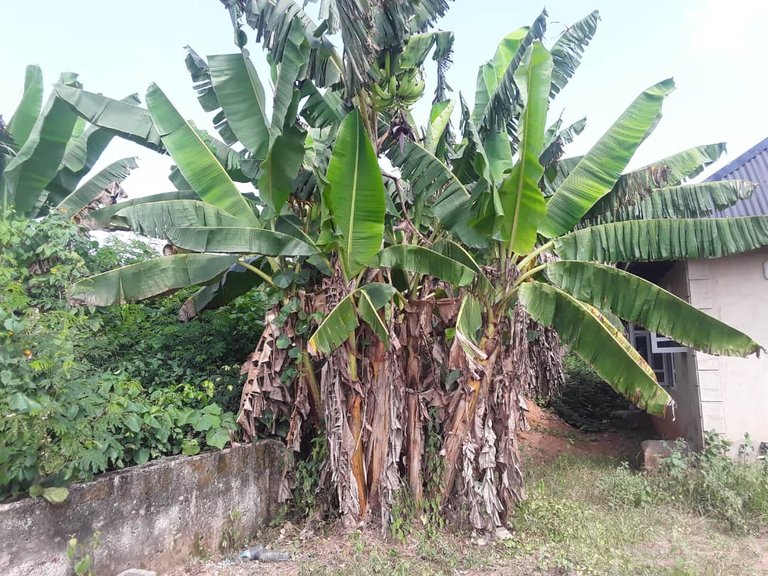I’ve always had a soft spot for plantain. Whether boiled, baked, or fried, there’s no denying its unique sweetness. For me, this affection goes beyond its taste—it’s also about the ease of cultivation and its resilience as a crop. Long-time readers of my blog already know this: plantain and I have a long-standing relationship.
Now, we’re at the peak of the harvest season in Nigeria, and plantain is dominating the agricultural scene. While the fruit is available year-round, its peak usually coincides with the end of the rainy season and the onset of the dry season. For those unfamiliar with Nigeria’s tropical climate, the rainy season typically starts in March, peaks in June or July, and gradually fades out by November. This timing makes now the perfect moment for plantain farmers, both large-scale and small-scale enthusiasts like myself, to bask in the glory of a bountiful harvest.

The Plantain Harvest Rush
The first few weeks of harvest are always a blur of activity. Enthusiasm runs high—freshly harvested plantains are fried, baked, boiled, and eagerly shared with family and friends. But as the harvest reaches its peak, abundance turns into a logistical headache. Suddenly, there’s more plantain than can be consumed, and the challenge of preserving the fruit begins.
For unripe plantains, the problem is manageable initially—they can be stored for a while without much fuss. But once ripening sets in, the race against time begins. Ripened plantains spoil quickly, and as a small-scale farmer, I don’t have access to industrial processing facilities that could extend their shelf life. So, I’ve had to devise my solutions to avoid waste.
My Go-To Preservation Technique: Plantain Flour
The most reliable method I’ve found is converting unripe plantain into plantain flour. This process is straightforward and requires minimal equipment. It starts immediately after harvest to prevent the fruits from ripening on the mother plant. Once harvested, the plantain bunch is dismantled and left to drain any sticky sap. Afterward, each fruit is peeled, sliced into thin pieces, and spread out to dry under the sun.
The drying process typically takes four to five days in sunny weather but can stretch to a week or more when the skies are cloudy. While I’ve thought about experimenting with oven-drying, I’ve always stuck with the sun—it feels more natural and, let’s be honest, it’s free!
Once thoroughly dried, the plantain slices are ground into a fine powder, creating plantain flour. This versatile flour is used to make a beloved local dish called amala, which is enjoyed with a variety of soups. Although I’ve heard of other creative uses for plantain flour—like bread, cakes, and pancakes—I’ve yet to try them myself.
A New Experiment: Plantain Swallow
Recently, my wife and I came across a video demonstrating another way to use plantain: making a swallow dish directly from the raw fruit. The process seemed simple—blend peeled plantain with a little water, cook it on the stove, and stir continuously until it thickens into a swallow-like consistency.

My latest harvest.
With excitement, we decided to give it a shot with our latest harvest. However, our first attempt was less than stellar. The result was a little too watery to be called a proper swallow. We suspect the culprit was using too much water during blending. But we’re not discouraged! We’re determined to try again and perfect the technique.
Other Plantain Possibilities?
While plantain flour and various cooking methods have served me well, I can’t help but wonder—what else can be done with this incredible fruit? Specifically, I’m on the lookout for simple, low-tech methods that don’t require specialized machinery.
Plantain chips come to mind, but they’re already a popular option in Nigeria. They’re delicious and easy to make, but I’d like to explore something different, perhaps a dish or snack that’s less common yet equally rewarding.
Plantain in Your Locality
What’s your favorite way to prepare plantain in your part of the world? Have you stumbled upon a creative or unique recipe that doesn’t demand industrial equipment? From traditional recipes to unconventional twists, I’m eager to learn and try new things.
Plantain is more than just a fruit; it’s a culinary and cultural treasure that adapts to countless uses. Whether it’s fried into crispy chips, transformed into flour for hearty dishes, or blended into an experimental swallow, its versatility never ceases to amaze me. As I navigate this season’s harvest, I’m excited to explore new possibilities and expand my plantain repertoire.
So, drop a comment or share your favorite plantain recipe—I can’t wait to hear from you!
Posted Using InLeo Alpha
Congratulations @gentleshaid! You have completed the following achievement on the Hive blockchain And have been rewarded with New badge(s)
Your next target is to reach 250000 upvotes.
Your next target is to reach 7000 comments.
You can view your badges on your board and compare yourself to others in the Ranking
If you no longer want to receive notifications, reply to this comment with the word
STOPCheck out our last posts:
Thanks for your contribution to the STEMsocial community. Feel free to join us on discord to get to know the rest of us!
Please consider delegating to the @stemsocial account (85% of the curation rewards are returned).
You may also include @stemsocial as a beneficiary of the rewards of this post to get a stronger support.